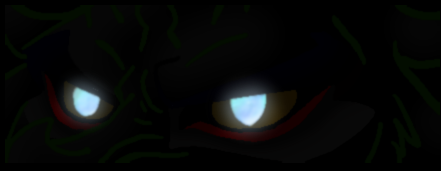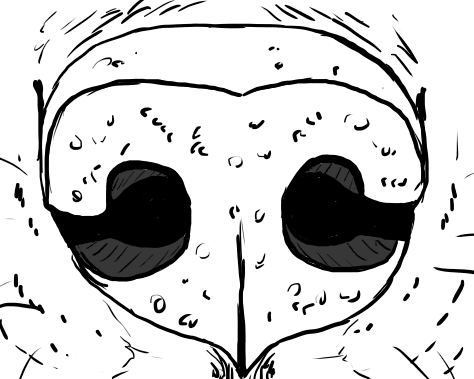Senses
Go back to SARS-CoV-2
Senses are very similar to that of wolves or dogs.
Eyes
The virus has almond shaped eyes and vertical slit pupils (like cats and foxes). Inside the eyes, behind the retina, is a layer of iridescent colors that reflect light. This layer is called the 'tapetum lucidum'. The tapetum lucidum makes it possible to see better in darkness and, when a little light shines on the eyes, the reflection of it makes the pupils appear to glow.

Tapetum lucidum may come in different colors. King Matthias has bluish colored tapetum.
The virus can't see well from a great distance due to naturally being born nearsighted. Chances are that, when a cell stands completely still in front of a virion at a certain distance, the virion can't see them. Especially red blood cells can do this, even when standing closer to the virion, because they blend in with the reddish colored surroundings. The virus is a dichromat, which means that it perceives the world in only two color hues, while other colors appear either yellowish or brownish (green and red) or bluish (purple/violet).
The eyes come in many different colors and different shades of said colors, but the most common colors are yellow and red. Other colors are green, brown and amber. More rare colors are blue, teal and purple. Especially purple is an extremely rare eye color. SARS-CoV-2 is prone to heterochromia too. This causes both eyes to have two different colors, or the iris to have two colors. This doesn't affect the eyes in any bad way, as heterochromia on its own isn't a disease, but it can be part of a disease if said disease causes damaging color changes in the eyes. The heterochromia described here is harmless and rather just a cool trait that a virion may be born with.

Virions have transparent nictitating membranes, which they use as 'diving goggles' when they dive under water. These membranes protect their eyes and help virions see clearly under water. Some virions may sleep with one or both eyes half open, and the black rims of the membranes may be seen covering a part of the eye.
Ears
SARS-CoV-2's hearing is similar to that of a dog, and thus 4 times better than human and cell hearing range. Virions can pick up tones that are between 67 Hz and 45,000 Hz in frequency. They can also hear noises that are otherwise inaudible to humans and cells, and noises that are far away.
Probiotic gut bacteria, who mastered the ability to make usable objects, sometimes make so called 'covid-flutes' which produce high-pitched tones. They and cells can't hear those tones, but SARS-CoV-2 can. Covid-flutes are meant to scare virions away, and bacteria may share these flutes with cells as a way to aid them in the battle against the virus, or as a protection against infection.
Ears come in all shapes and sizes, mostly similar to dog ears. Some virions, like the one pictured on above first image, can have pointy ears which look like they've been cropped (as seen in some dog breeds, like the dobermann or great dane), but aren't really. The pointy ears are just a design choice made by me, for the sake of diversity in character designs.
The ears can be closed whenever a virion dives under water. This is not only to prevent water entering the ears, but also to prevent the eardrums from being damaged by pressure. The ears can be closed off with a valve-like structure inside the ear canals. Same mechanic may be used when a virion is bothered by a too sharp, loud or simply annoying noise. So, basically, SARS-CoV-2 virions are born with built-in earplugs.
Nose

Even though I don't always draw the noses of characters as detailed as this, the noses of all characters do in fact look like this.
The nose is dog-like and wet. SARS-CoV-2's sense of smell is as sensitive as a dog and virions can smell scents from a far distance. Even faint scents are still noticed. One virion has a more sensitive nose than the other though, especially if said virion has a long snout and thus more scent receptors. When sniffing, air will be inhaled via the nostrils, but exhaled via the slits at the sides of the nose. This helps to separate exhaled old scent particles from the inhaled new ones, and thus not interfering with an additional second picked up scent trail. Virions can differentiate between different type of cells by their scent.
Like many animals, SARS-CoV-2 can pick up some pheromone-based scents with a specialized organ in their hard palate, the vomeronasal organ. They are sensitive to the pheromones of permissive cells too, which is why they know exactly which cell to select and infect.
Just like the ears, the nostrils can be closed off with valve-like structures. This is so water won't be able to enter the nostrils.
Taste
Given it doesn't need to eat, SARS-CoV-2 evolved to have no taste buds. Virions don't taste anything when they do lick at something.
Whiskers
The virus can feel vibrations with its whiskers. Virions specifically make use of this ability to 'see' the distance between them and an obstacle, in places where it's so dark that even they can't see anything.
*I mostly don't draw whiskers on my SARS-CoV-2 characters. I do draw the 'whisker dots' on their snouts though, so said characters obviously do have whiskers (but just not visible!).




